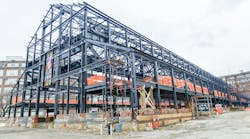Warehousing and Logistics Construction Is Booming, but Safety Needs to Be Prioritized
Several years removed from the supply chain issues that characterized the COVID-19 pandemic, companies continue to invest heavily in warehousing and logistics across the country. The factors driving the boom should sound familiar: a growing e-commerce market, driven both by the familiar powerhouses as well as more niche direct-to-consumer options, as well as general upgrades to infrastructure, distribution centers, transit links, and last-mile facilities close to consumers—the need for which became glaringly apparent during COVID-19.
The U.S. government also continues to incentivize the reshoring of U.S. manufacturing, which has driven the demand for warehouses increasingly upward; according to the Bureau of Labor Statistics, the value of new warehouse construction increased from $42 billion to $61 billion between 2020 and 2022. Warehouses are being constructed not only with larger physical footprints, but also taller than ever before. With increased demand comes increased expectations for delivery. Construction executives claim they are being pushed to complete facilities as quickly as possible, with immense schedule pressure from clients.
Despite the temptation to move quickly, the combination of “speed” and “construction” rarely results in positive outcomes, and there have been numerous reported instances in recent years involving safety lapses in both warehouse construction and operation. According to the Bureau of Labor Statistics, in 2022 construction had the most worker deaths of any industry. Even beyond the obvious unnecessary and tragic loss of life, the potential consequences for companies are costly. In March 2024, a worker at an Amazon warehouse reconstruction project was awarded $4 million after he fell through a roof hole and suffered a severe head injury. Workers’ compensation costs continue to rise; according to the National Council on Compensation Insurance, most recent data shows that the average cost of a construction injury claim is $41,353.
By nature, warehouse construction has potential for some of the riskiest construction activities, including the consistent use of cranes, working at heights, the use of heavy construction equipment, electrical work, and hot work. Many of these activities fall amongst OSHA’s “fatal four” construction hazards (falls, struck-by, electrocution, caught in-between), which are the leading causes of death in the construction industry. Urgent demand may also result in the use of inexperienced contractors or subcontractors who are unfamiliar with warehouse construction. These factors, in addition to the hazards inherently present in any construction project, present a risk profile that cannot be ignored.
A Rising Tide of Risk and Regulatory Attention
Warehouse operation poses its own longer-term challenges. On a daily basis, many workers share their workplace with heavy machinery, robotics equipment, assembly lines, powered industrial trucks (i.e., forklifts or lift trucks), hazardous chemicals, and energized electrical equipment, and take part in the frequent handling and lifting of large quantities of materials.
According to the Bureau of Labor Statistics, the number of workers employed in the warehousing and storage industry increased by 42% between 2020 and 2023. New workers have a higher probability of being injured as compared to their more experienced counterparts, and as demand for labor brings workers with no previous experience working in these facilities, both worker and employer are at more risk than ever. Unsurprisingly, the number of annual fatalities in the warehousing and storage sector doubled from 2020 to 2022.
In November 2023, a 20-year-old worker at an Indiana warehouse died after being trapped under machinery, and warehouse owners are coming under increasing amounts of legal scrutiny over similar shortcomings related to worker safety. A 2023 U.S. Department of Labor Office of the Inspector General Report found that warehouses had an injury and illness rate that was more than double the rate across all industries. The U.S. Senate has launched an investigation into Amazon’s warehouse safety practices, claiming “egregious health and safety violations,” “failing to adopt adequate worker protections,” and failing to properly record work-related injuries at several of its warehouses.
In addition to issuing a significant number of violations, OSHA has opened a national investigation into ergonomic injuries at Amazon warehouses, and the Southern District of New York is investigating “workplace safety and related issues at Amazon warehouses” and allegations that Amazon did not appropriately report on-the-job injuries.
A Proactive Approach
The private construction and warehousing sectors need to prioritize safety as a core principle of any engagement. Investing in a culture of safety during construction can not only save lives, it can help keep project schedules on track, protect return on investment, reduce time away from work, and decrease workers’ compensation costs. Employee morale and retention rates also improve when workers feel like their safety and well-being are taken into consideration.
In our frequent work with the industry, we’ve observed that a number of steps need to become standard practice:
Bringing on an independent safety expert to evaluate health and safety programs. This needs to be one of the first commitments made before shovels hit the dirt. The independent nature of these services can be extremely beneficial to owners due not only to the unbiased nature an independent expert provides, but also to the lack of any potential competing objectives.
Implementing enhancements to health and safety processes. Ensuring these enhancements are made across all safety areas including worker safety training, injury reporting, safety staffing, hazard identification, and regulatory compliance will help create a robust safety program with no gaps that complies with regulatory standards.
Performing periodic safety field audits. Such audits build a strong culture of safety, and ensure that facilities are adhering to necessary regulatory requirements. Independent audits by safety professionals, while collaborative, can help to avoid complacency among the contractors and/or workforce and keep safety at the forefront.
Keeping safety a priority benefits all parties involved in this industry. Assuring that workers return home safely every day is not only a moral obligation, but also is the best way to ensure the successful completion of your project.



